Effect of Organic Compounds on the Special Properties and the Microstructure of Autoclaved Brick
Abstract
1. Introduction
2. Materials and Methods
2.1. Research Plan
2.2. Determination of the Composition of a Lime-Sand Mixture Modified with a Selected Organic Mo-Difier in a Liquid Form
2.3. Laboratory Tests
- -
- Compressive strength using the Tecnotest KC 300 hydraulic press (Figure 8b);
- -
- Bulk density;
- -
- Absorption due to rising capillary;
- -
- Pore size and arrangement;
- -
- X-ray examinations.
3. Results
3.1. Compressive Strength and Bulk Density Testing
3.2. Water Absorption Test
- cwi,s—initial water absorption of masonry elements,
- mso,s—mass of the sample in grams after soaking with water at time “t”,
- mdry,s—mass of the sample after drying,
- As—total face area of the sample immersed in water [mm2],
- t—water saturation time [s].

3.3. Examination of the Microstructure of a Silicate Product
3.4. X-ray Examination
4. Usefulness of Modified Silicate Products
5. Conclusions
- -
- Increased compressive strength of silicate brick. Modifying the element with 10% of organic compounds favorably influenced both the compressive strength of the product (42.04 MPa) and the bulk density (2.11 kg/dm3). For the control sample, the compressive strength was (20.51 MPa), and the volume density (1.73 kg/dm3);
- -
- Improved performance properties (reduced water absorption, during the capillary rise test (water absorption). The samples absorbed water in an amount from 1/3 to ½ less compared to a standard sand–lime product);
- -
- The microstructure of the silicate product indicates the presence of the tobermorite phase as the main phase and the C-S-H phase as the deciphyte phase. Under the influence of autoclaving, high temperature, and pressure in the autoclave, the C-S-H phase usually crystallizes in the direction of tobermorite, which is also related to the amount of binder in the material.
- -
- Can be used as foundation blocks;
- -
- Classifying the silicate product as a sustainable material (material in the form of aggregate can be recovered after the expected period of use);
- -
- There were opportunities to improve the technological process of producing silicate products in terms of effective use of energy, thanks to the use of mix modifiers in liquid form.
Author Contributions
Funding
Institutional Review Board Statement
Data Availability Statement
Acknowledgments
Conflicts of Interest
Abbreviations
| X1 (HA) | Humus Activ [%] |
| X2 (BEU) | Biohumus Extra Universal [%] |
| σ | Compressive strength [MPa] |
| ρ | Bulk density [kg/dm3] |
| cwi,s | Water absorption [%] |
| SEM | Scanning electron microscope |
| XRD | X-ray crystallography |
References
- Ullah, A.; Ali, M.; Shahzad, K.; Ahmad, F.; Iqbal, S.; Rahman, M.H.U.; Ahmad, S.; Iqbal, M.M.; Danish, S.; Fahad, S.; et al. Impact of Seed Dressing and Soil Application of Potassium Humate on Cotton Plants Productivity and Fiber Quality. Plants 2020, 9, 1444. [Google Scholar] [CrossRef] [PubMed]
- Zapotoczna-Sytek, G. Naturalna promieniotwórczość wyrobów budowlanych, w tym autoklawizowanego betonu komórkowego (ABK). Przegląd Bud. 2012, 83, 39–42. [Google Scholar]
- Fiormarkets. ‘Global Silica Brick Market’ Research Report. Global Silica Brick Market, Forecast to 2030. Fior Mark. Res. 2022, 1–187. [Google Scholar]
- Kołacz, B. Znaczenie Materii Organicznej W Glebie Oraz Działania Agrotechniczne Wspomagające Jej Utrzymanie; Centrum Doradztwa Rolniczego w Brwinowie Oddział w Radomiu: Radom, Poland, 2020. [Google Scholar]
- Kononova, M.M. The Soil’s Humic Substances–Results and Problems in Humus Research. 1958. Available online: https://www.ecofarmingdaily.com/build-soil/humus/building-humus-for-all-crops/ (accessed on 3 October 2022).
- Aytekin, A.; Aynur, A.O. Hormone and Microorganism Treatments in the Cultivation of Saffron (Crocus Sativus L.). Plants. Molecules 2008, 13, 1135–1147. [Google Scholar] [CrossRef] [PubMed]
- Hussain, N.; Abbasi, S.A. Efficacy of the Vermicomposts of Different Organic Wastes as “Clean” Fertilizers: State-of-the-Art. Sustainability 2018, 10, 1205. [Google Scholar] [CrossRef]
- Allaga, H.; Bóka, B.; Nagy, V.D.; Szűcs, A.; Stankovics, I.; Takó, M.; Manczinger, L.; Vágvölgyi, C.; Kredics, L.; Körmöczi, P. Composite Bioinoculant Based on the Combined Application of Beneficial Bacteria and Fungi. Agronomy 2020, 10, 220. [Google Scholar] [CrossRef]
- Jakubus, M.A. Comparative Study of Composts Prepared from Various Organic Wastes Based on Biological and Chemical Parameters. Agronomy 2020, 10, 869. [Google Scholar] [CrossRef]
- Vitti, A.; Elshafie, H.S.; Logozzo, G.; Marzario, S.; Scopa, A.; Camele, I.; Nuzzaci, M. Physico-Chemical Characterization and Biological Activities of a Digestate and a More Stabilized Digestate-Derived Compost from Agro-Waste. Plants 2021, 10, 386. [Google Scholar] [CrossRef]
- Kowalska, A.; Grobelak, A.; Almås, A.R.; Singh, B.R. Effect of Biowastes on Soil Remediation, Plant Productivity and Soil Organic Carbon Sequestration: A Review. Energies 2020, 13, 5813. [Google Scholar] [CrossRef]
- Szufa, S.; Piersa, P.; Adrian, Ł.; Sielski, J.; Grzesik, M.; Romanowska-Duda, Z.; Piotrowski, K.; Lewandowska, W. Acquisition of Torrefied Biomass from Jerusalem Artichoke Grown in a Closed Circular System Using Biogas. Plant Waste. Molecules 2020, 25, 3862. [Google Scholar] [CrossRef]
- Sojka, M.; Saeid, A. Chapter 10—Bio-based products for agriculture. In Smart Agrochemicals for Sustainable Agriculture; Elsevier: Amsterdam, The Netherlands, 2022; pp. 279–310. [Google Scholar] [CrossRef]
- Pidlisnyuk, V.; Herts, A.; Khomenchuk, V.; Kononchuk, O.; Ust’ak, S. Dynamic of Morphogical and Physiological Parameters and Variation of Soil Characteristics during Miscanthus giganteus Cultivation in the Diesel-Contaminated. Land. Agron. 2021, 11, 798. [Google Scholar] [CrossRef]
- Lian, H.; Wang, Z.; Li, Y.; Xu, H.; Zhang, H.; Gong, X.; Qi, H.; Jiang, Y. Straw Strip Return Increases Soil Organic Carbon Sequestration by Optimizing Organic and Humus Carbon in Aggregates of Mollisols in Northeast China. Agronomy 2022, 12, 784. [Google Scholar] [CrossRef]
- Tripolskaja, L.; Kazlauskaite-Jadzevice, A.; Baksiene, E.; Razukas, A. Changes in Organic Carbon in Mineral Topsoil of a Formerly Cultivated Arenosol under Different Land Uses in Lithuania. Agriculture 2022, 12, 488. [Google Scholar] [CrossRef]
- Blakemore, R.J. Critical Decline of Earthworms from Organic Origins under Intensive, Humic SOM-Depleting Agriculture. Soil Syst. 2018, 2, 33. [Google Scholar] [CrossRef]
- Korkina, I.N.; Vorobeichik, E.L. Non-typical degraded and regraded humus forms in metal-contaminated areas, or there and back again. Geoderma 2021, 404, 115390. [Google Scholar] [CrossRef]
- Vogel, S.; Bönecke, E.; Kling, C.; Kramer, E.; Lück, K.; Nagel, A.; Philipp, G.; Rühlmann, J.; Schröter, I.; Gebbers, R. Base Neutralizing Capacity of Agricultural Soils in a Quaternary Landscape of North-East Germany and Its Relationship to Best Management Practices in Lime Requirement Determination. Agronomy 2020, 10, 877. [Google Scholar] [CrossRef]
- Watabe, A.; Fukuda, K.; Saito, T. Patent 62-090530—Soil Activator. 1987. [Google Scholar]
- Charier, G.A.; Le Guerinel, H.; Raimbault, S.; Jeanneau, S. Organo-Mineral Soil Amendment Comprising Synergistic Mixture of Lime-Treated Household Rubbish and Plant Compost, Having e.g., Structuring, Clay-Humus Complex Formation and Aeration Promoting Effects. Patent FR2823502A1, 18 October 2002. [Google Scholar]
- Nebehaj, I.; Venesz, B.; Odor, G.; Csapo, F.; Szuecs, L. Process for Producing Biohumus Withincreased Microelement Content. Patent HUT57688A, 30 December 1991. [Google Scholar]
- Stepien, A. Analysis of Porous Structure in Autoclaved Materials Modified by Glass Sand. Crystals 2021, 11, 408. [Google Scholar] [CrossRef]
- Kostrzewa-Demczuk, P.; Stepien, A.; Dachowski, R.; Krugiełka, A. The use of basalt powder in autoclaved brick as a method of production waste management. J. Clean. Prod. 2021, 320, 128900. [Google Scholar] [CrossRef]
- Stepien, A.; Potrzeszcz-Sut, B.; Prentice, D.P.; Oey, T.J.; Balonis, M. The Role of Glass Compounds in Autoclaved Bricks. Buildings 2020, 10, 41. [Google Scholar] [CrossRef]
- Borek, K.; Czapik, P.; Dachowski, R. Recycled Glass as a Substitute for Quartz Sand in Silicate Products. Materials 2020, 13, 1030. [Google Scholar] [CrossRef]
- Stepien, A.; Leśniak, M.; Sitarz, M.A. Sustainable Autoclaved Material Made of Glass Sand. Buildings 2019, 9, 232. [Google Scholar] [CrossRef]
- Stepien, A.; Kostrzewa, P.; Dachowski, R. Influence of barium and lithium compounds on silica autoclaved materials properties and on the microstructure. J. Clean. Prod. 2019, 236, 117507. [Google Scholar] [CrossRef]
- Stepien, A.; Kostrzewa, P. The impact of basalt components on the structure of bricks formed as a result of hydrothermal treatment. Buildings 2019, 9, 192. [Google Scholar] [CrossRef]
- Pytel, Z.; Małolepszy, J. Wykorzystanie błota pochromowego w produkcji wyrobów wapienno-piaskowych. Mater. Bud. 1990, 6, 14–15. [Google Scholar]
- Malhotra, S.K.; Tehri, S.P. Development of bricks from granulated blast furnace slag. Constr. Build. Mater. 1996, 10, 191–192. [Google Scholar] [CrossRef]
- Witthohn, M.; Klemm, R. Proces zwiększania pojemności cieplnej cegieł wapienno-silikatowych oraz cegła z materiału wapienno-silikatowego. Available online: https://patents.google.com/patent/PL1752509T3/fr (accessed on 3 October 2022).
- Bavasso, I.; Vilardi, G.; Sebastiani, D.; Di Giulio, A.; Di Felice, M.; Di Biase, A.; Miliziano, S.; Di Palma, L. Rapid Experimental Procedure to Assess Environmental Compatibility of Conditioning Mixtures Used in TBM-EPB Technology. Appl. Sci. 2020, 10, 4138. [Google Scholar] [CrossRef]
- PN-EN 772-1; 2011E: Metody badań elementów murowych. Część 1 Określenie wytrzymałości na ściskanie, Wymagania dotyczące elementów murowych. Część 2. Elementy murowe silikatowe. CEN: Brussels, Belgium, 2011.
- PN-EN 772-13; 2001 Methods of Test for Masonry Units-Part 13: Determination of the Density of the Net and Gross Density of Masonry in the Dry State (Except for Natural Stone). CEN: Brussels, Belgium, 2001.
- PN-EN 1996-2; 2010 Eurocode 6-Design of Masonry Structures-Part 2: Design, Selection of Materials and Execution of Masonry. CEN: Brussels, Belgium, 2010.
- PN-EN 771-2; Specification for Masonry Units. Part 2: Calcium Silicate Masonry Units. CEN: Brussels, Belgium, 2010.
- Nermend, K. Metody Analizy Wielokryterialnej i Wielowymiarowej We Wspomaganiu Decyzji. Wydawnictwo Naukowe PWN. 2020. Available online: https://ksiegarnia.pwn.pl/Metody-analizy-wielokryterialnej-i-wielowymiarowej-we-wspomaganiu-decyzji,734403196,p.html (accessed on 3 October 2022).
- Szafranko, E. Applicability of multi-criteria analysis methods for the choice of material and technology solutions in building structures. Teh. Vjesn. 2017, 24, 1935–1940. [Google Scholar]
- Szafranko, E. Application of multi-criterial analytical methods for ranking environmental criteria in an assessment of a development project. J. Ecol. Eng. 2017, 18, 151–159. [Google Scholar] [CrossRef]
- Sagan, A. Jeden obraz ukazuje więcej niż 10 liczb, czyli jak budować mapy zadowolenia klienta z wykorzystaniem programu Statistica. Statsoft Pol. 2004, 12, 35–50. [Google Scholar]
- Gabriel, K.R. Biplot display of multivariate matrices for inspection of data and diagnois. In Intrepreting Multivariate Data; Barnett, V., Ed.; John Wiley & Sons: London, UK, 1981. [Google Scholar]
- Pakiet Oprogramowania do Zaawansowanej Analizy Danych, Statistica 10.0; StatSoft Inc.: Tulsa, OK, USA, 1989.
- Abdoliyazdi, N.; Arefi, M.R.; Mollaahmadi, E.; Abdollahi, B. To study the effect of adding Fe2O3 nanoparticle on the morphology properties and microstructure of cement mortar. Life Sci. J. 2011, 8, 1–6. [Google Scholar]
- Largeau, M.A.; Mutuku, R.; Thuo, J. Effect of Iron Powder (Fe2O3) on Strength, Workability, and Porosity of the Binary Blended Concrete. Open J. Civ. Eng. 2018, 8, 411–425, ISSN Online: 2164-3172. [Google Scholar] [CrossRef]
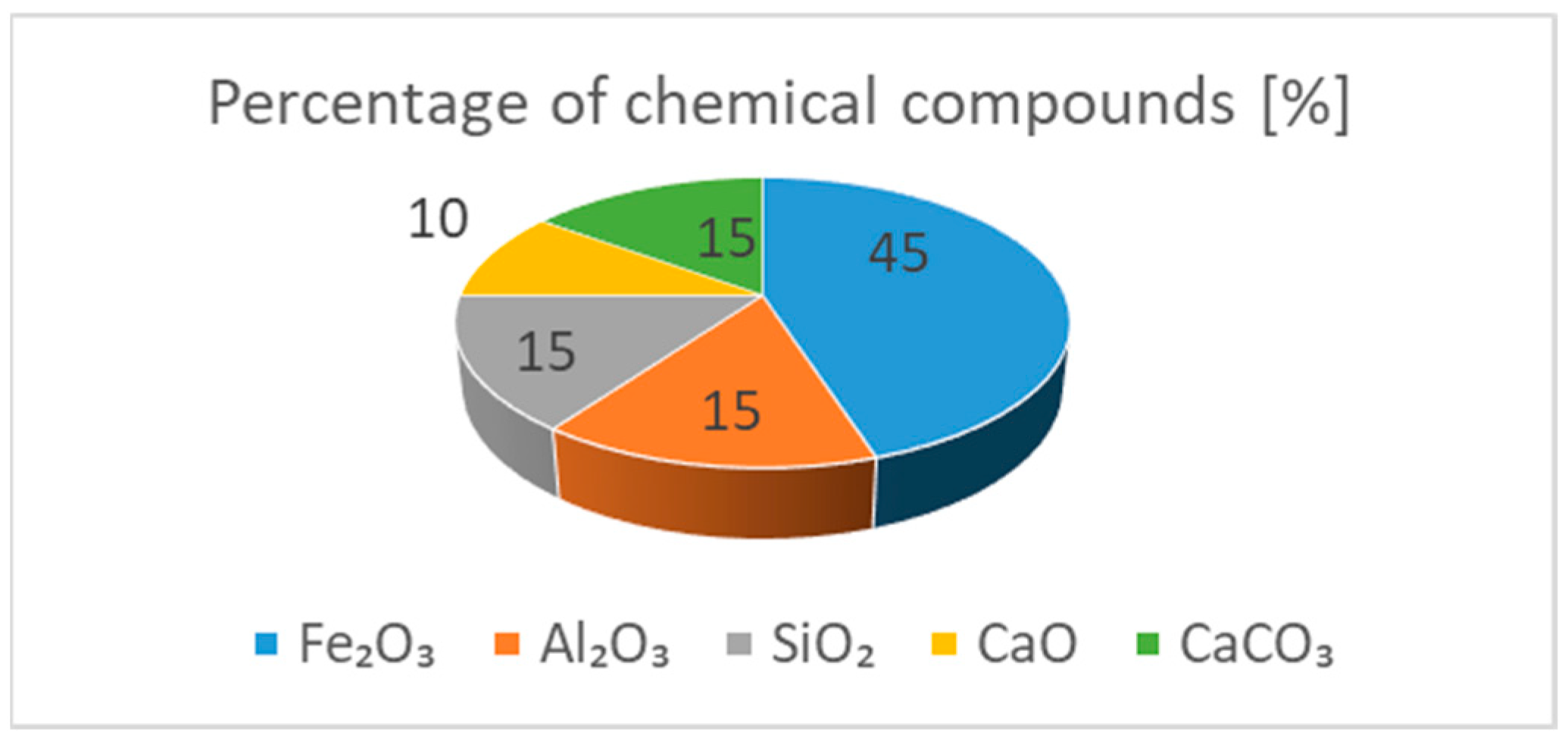

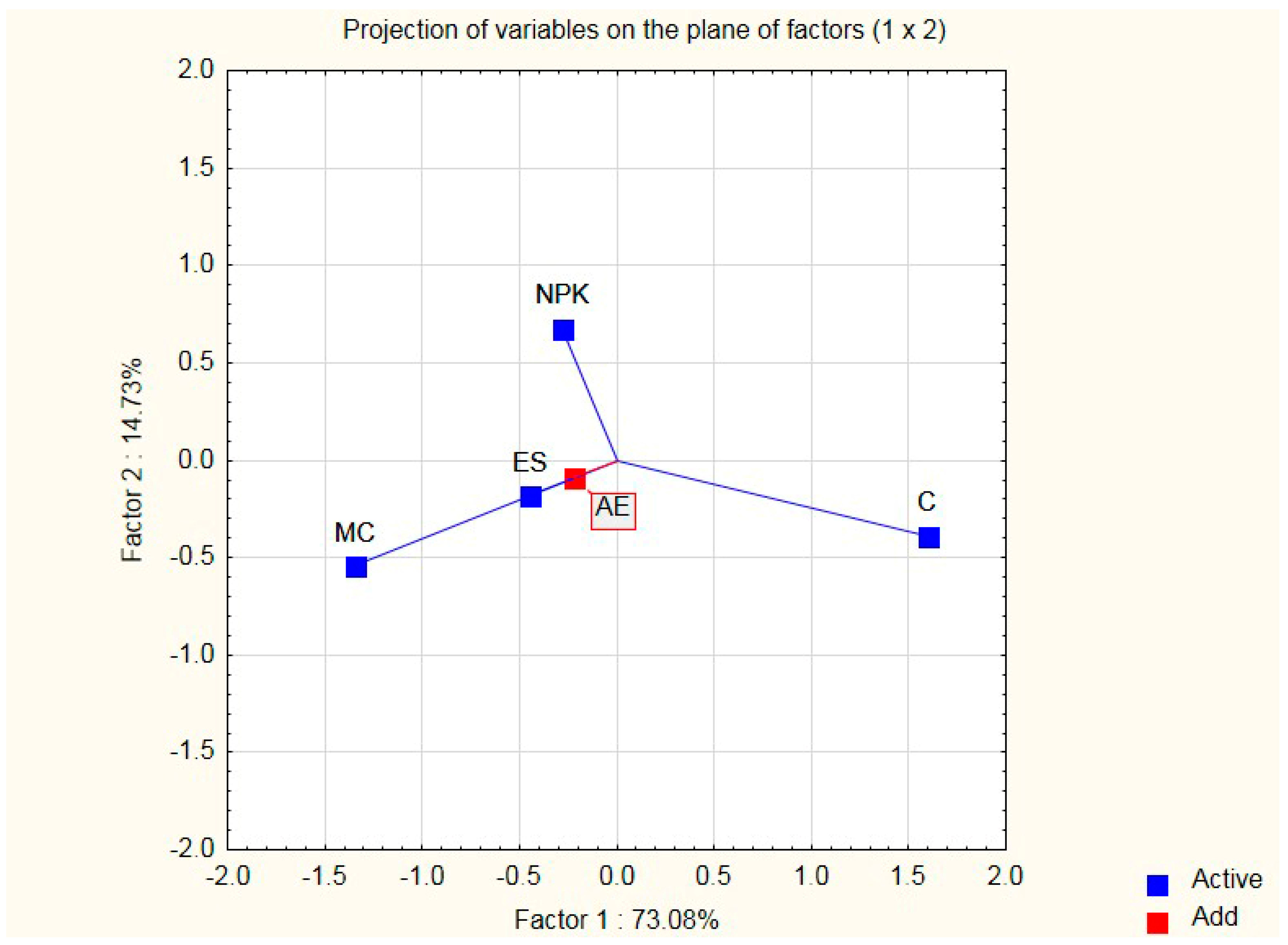
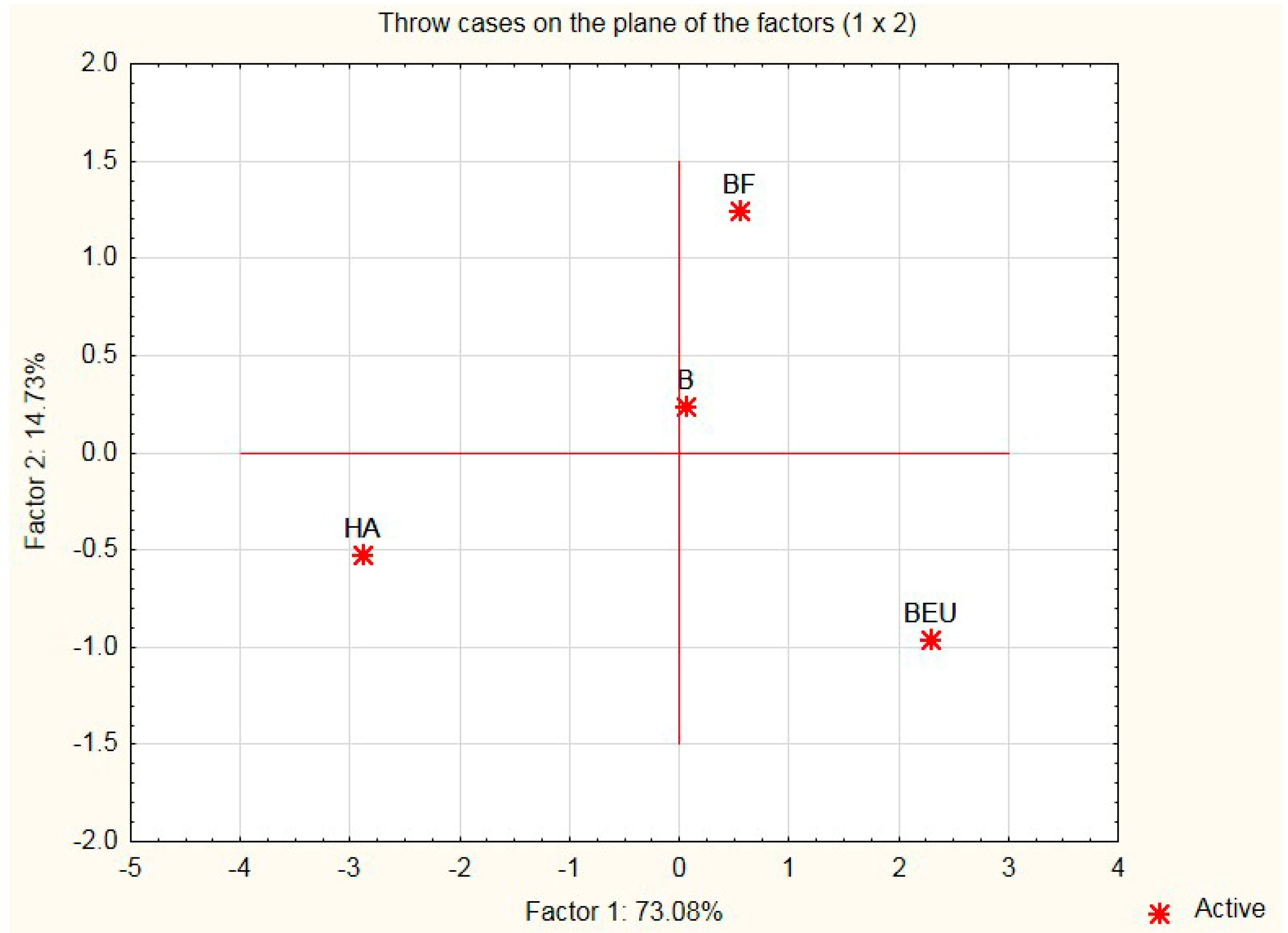

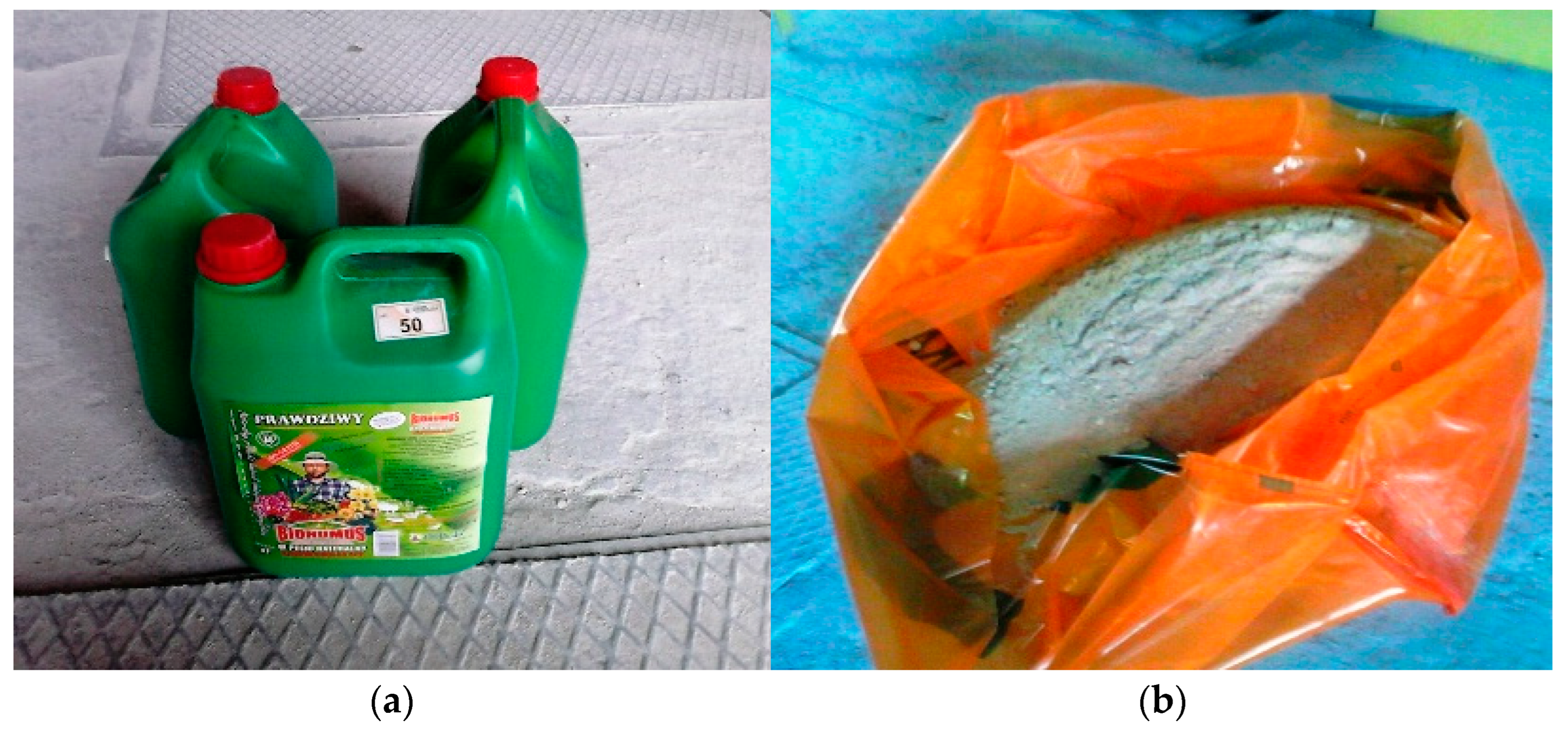





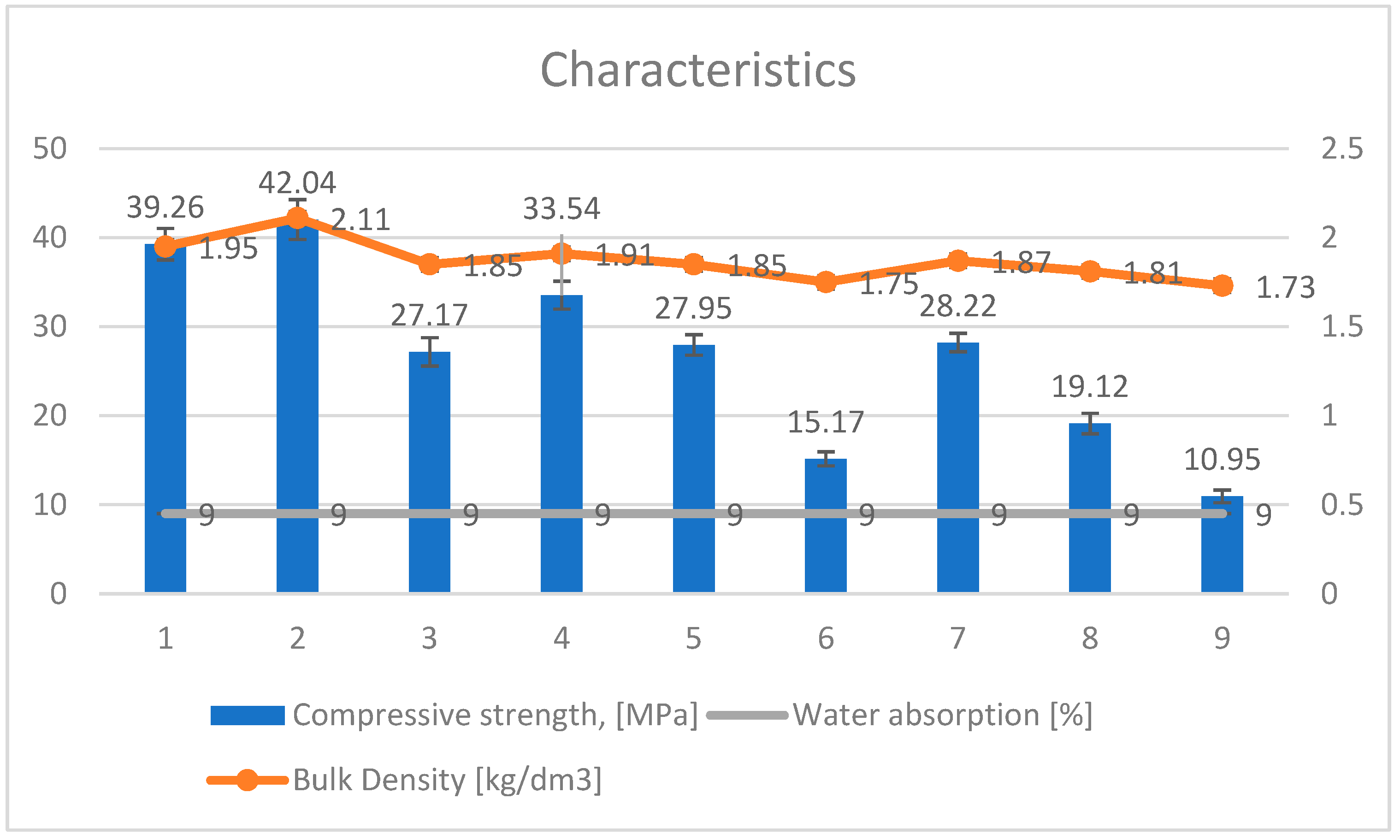

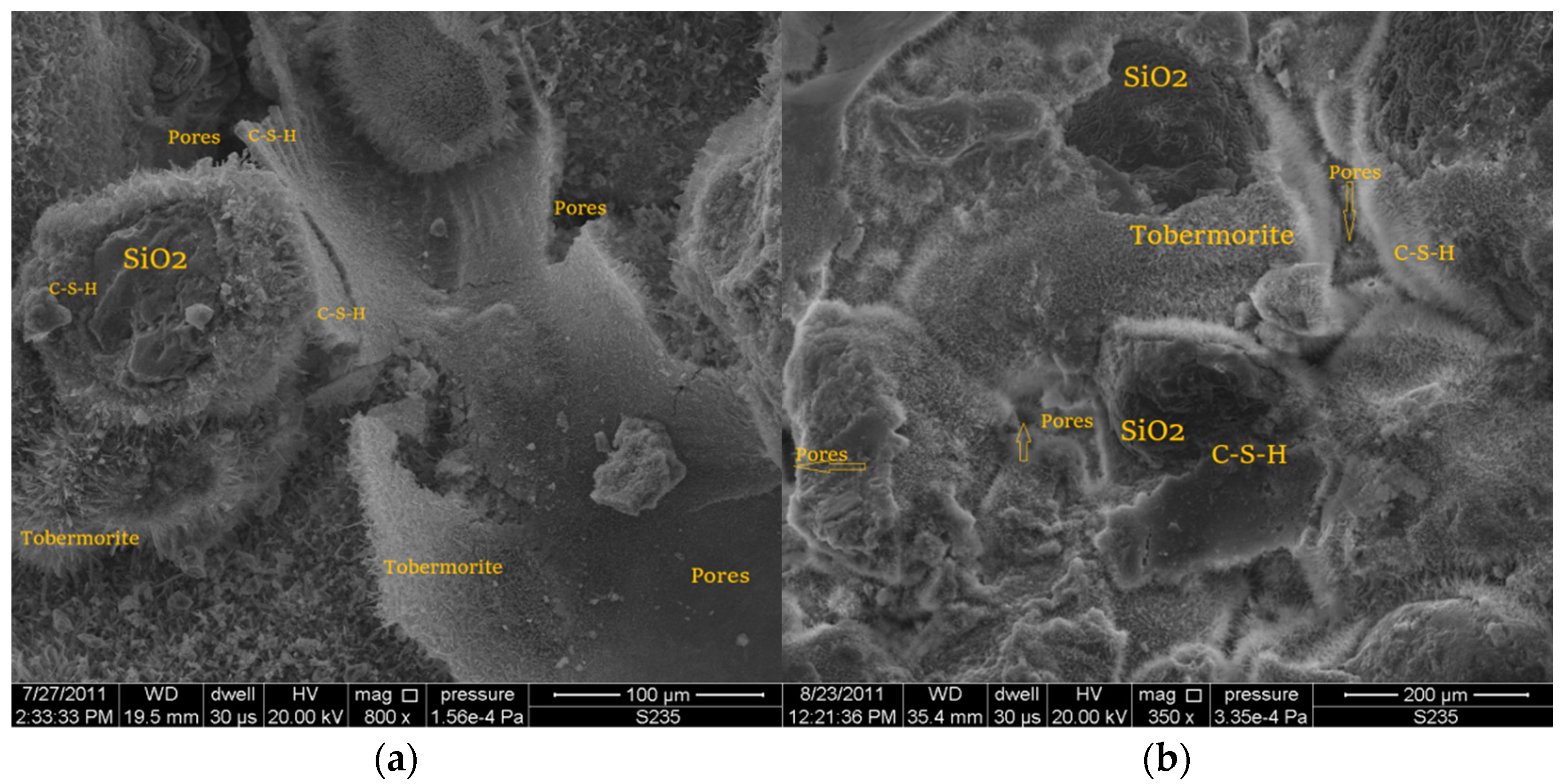
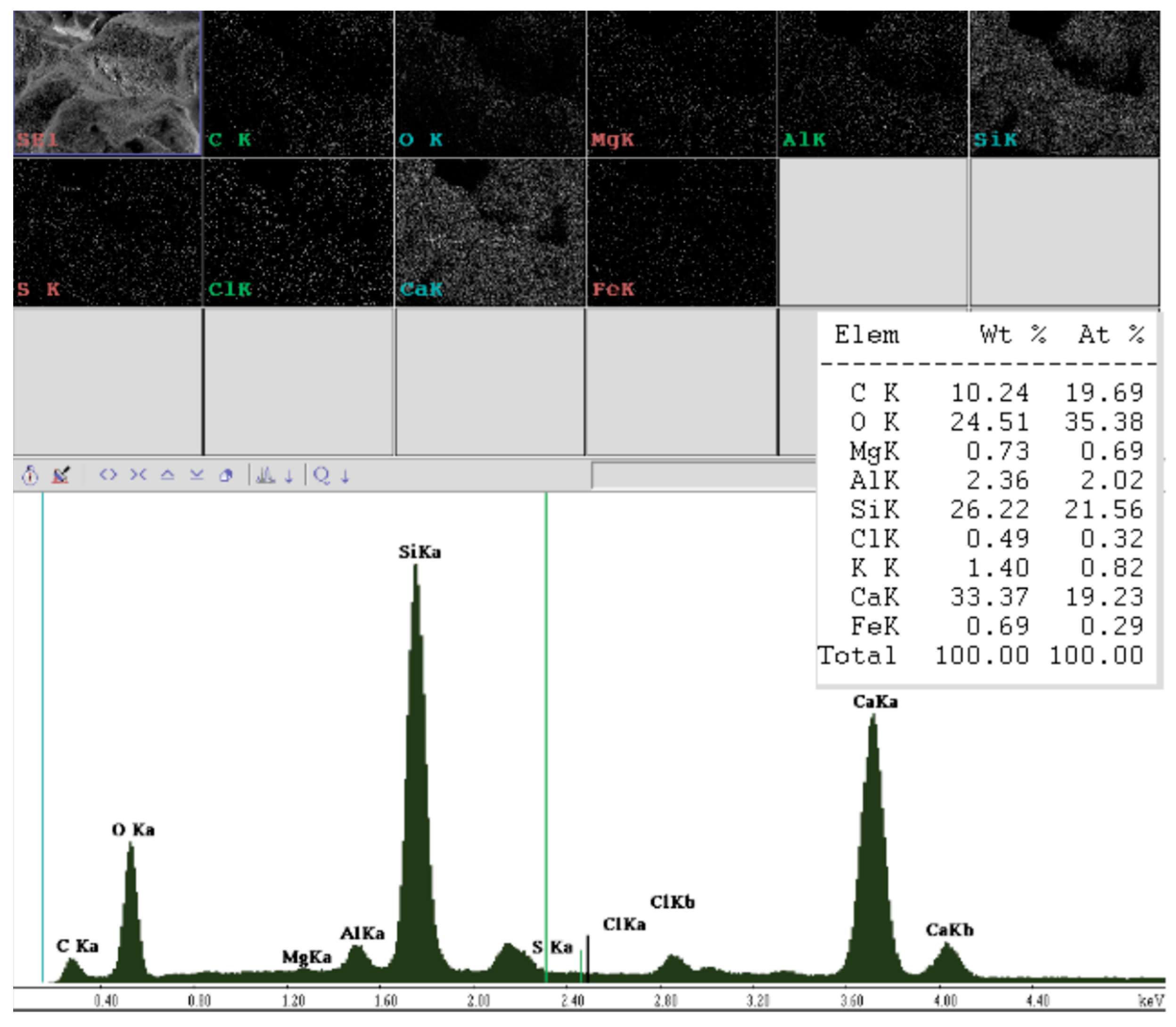
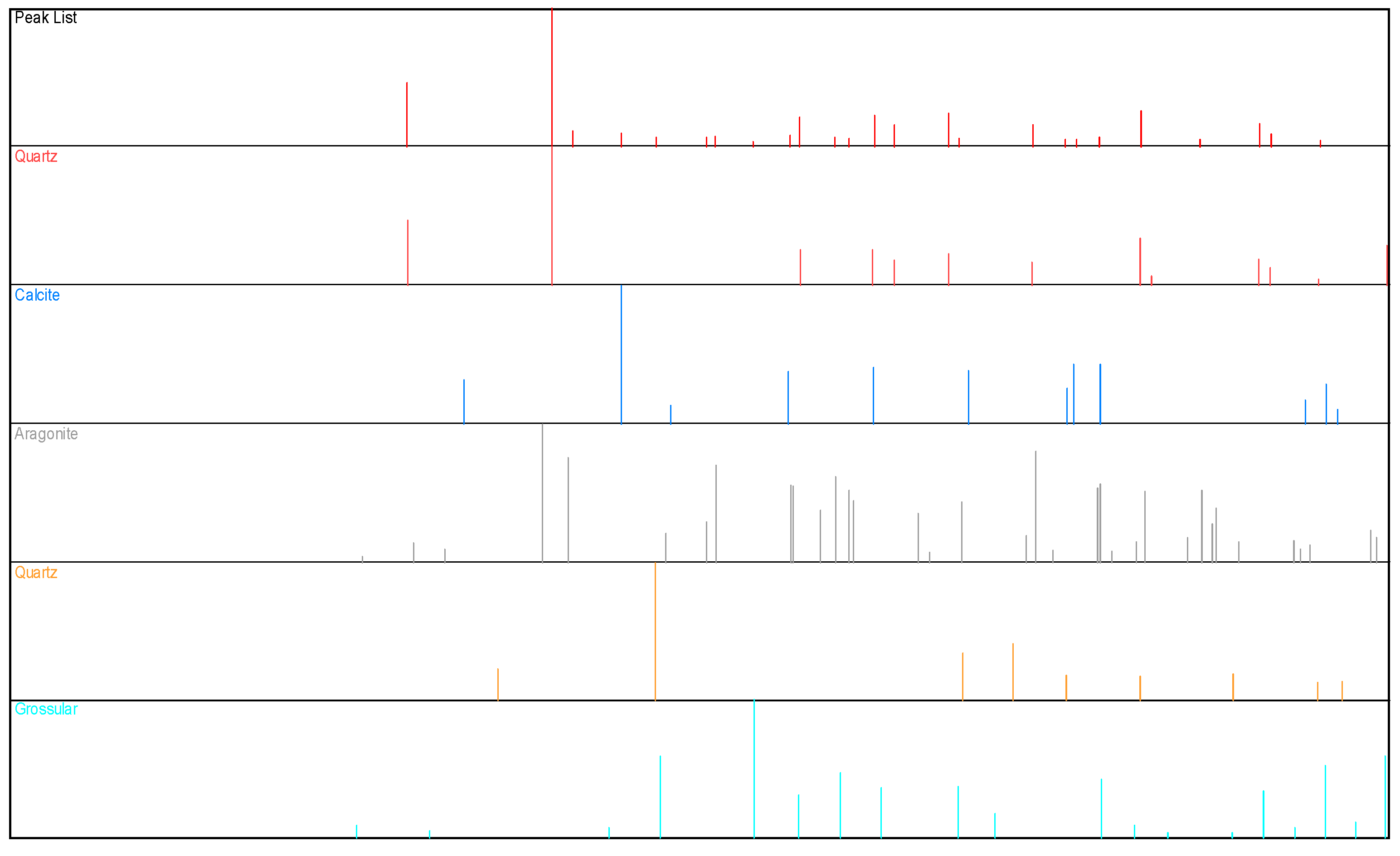
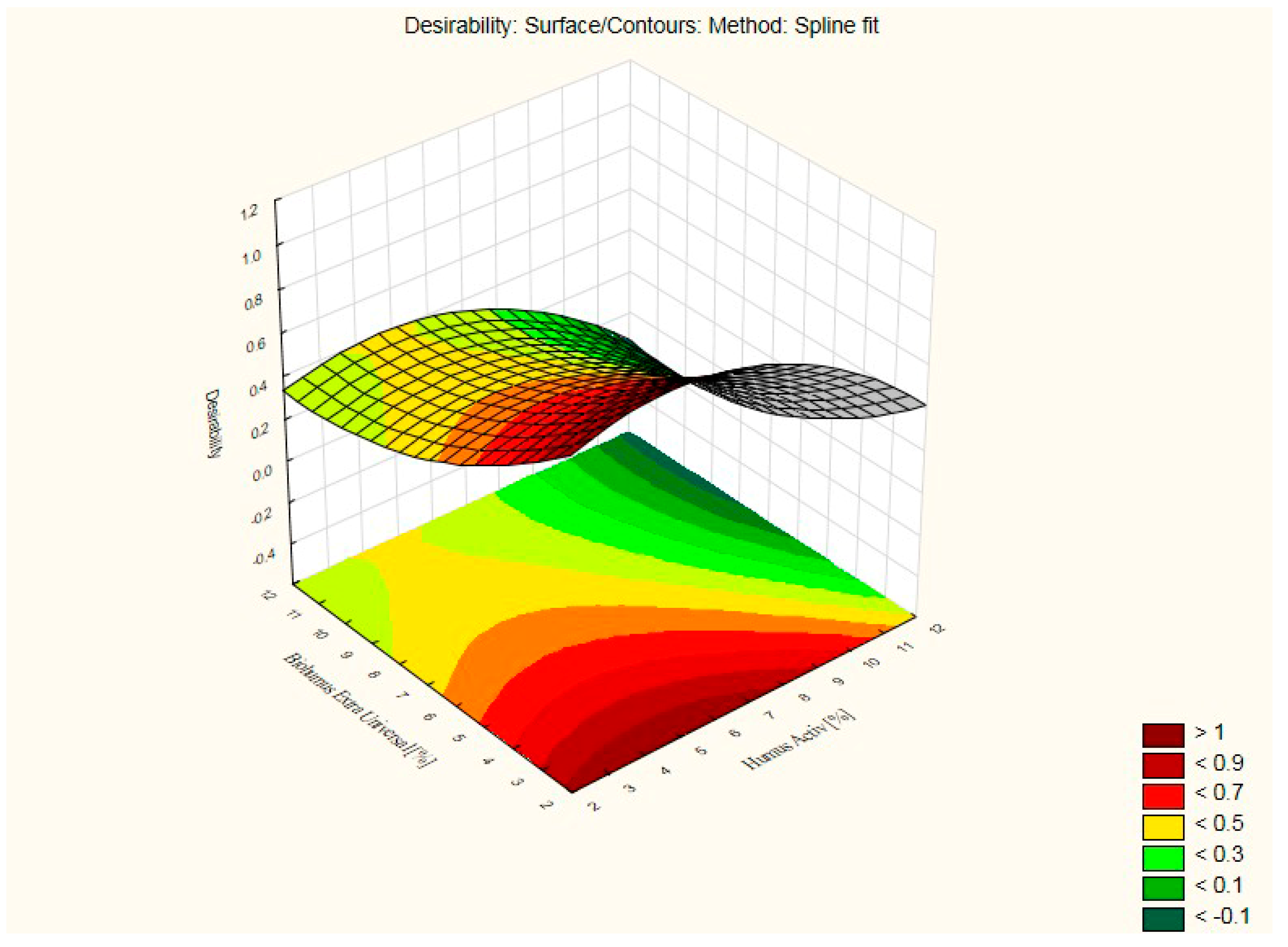
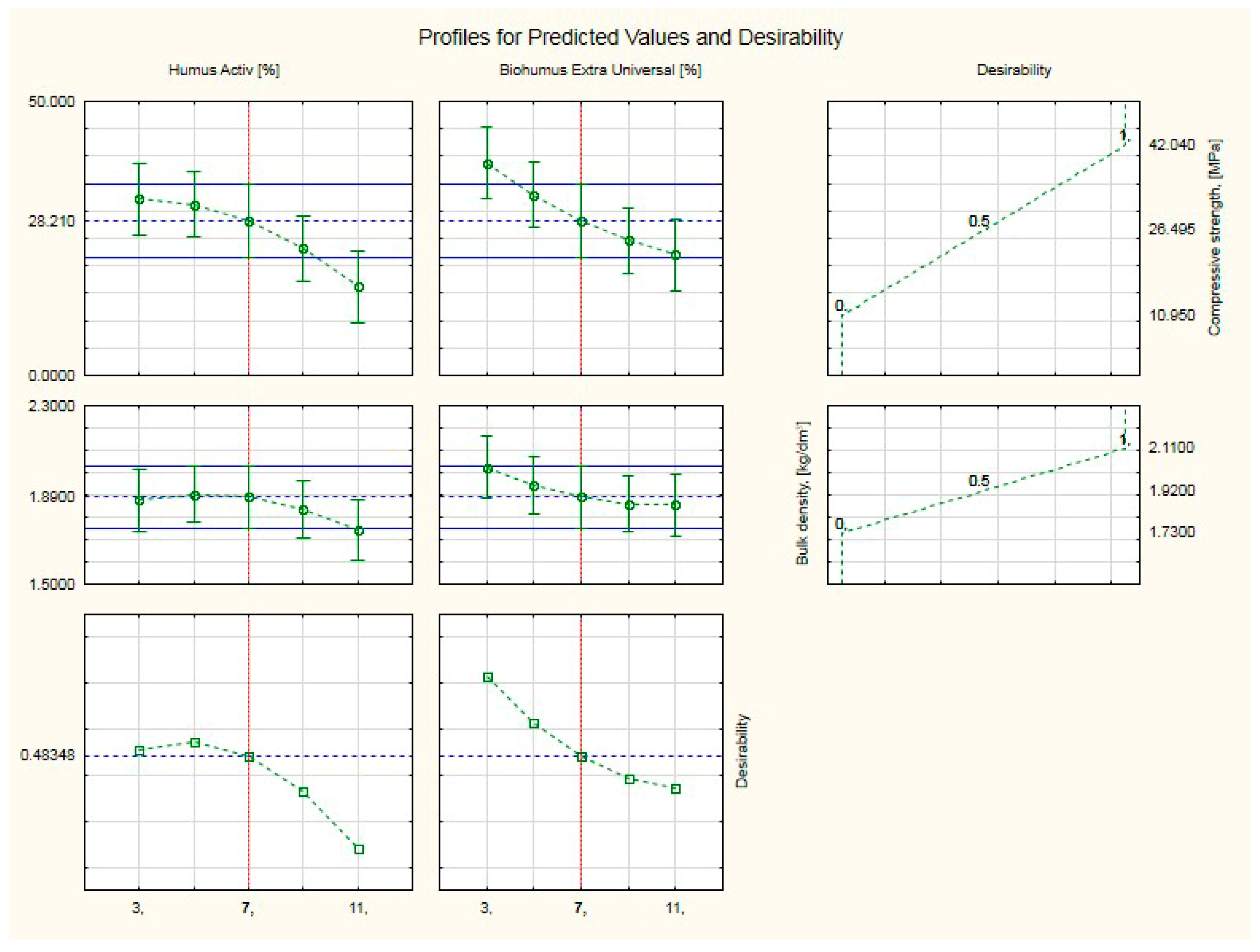
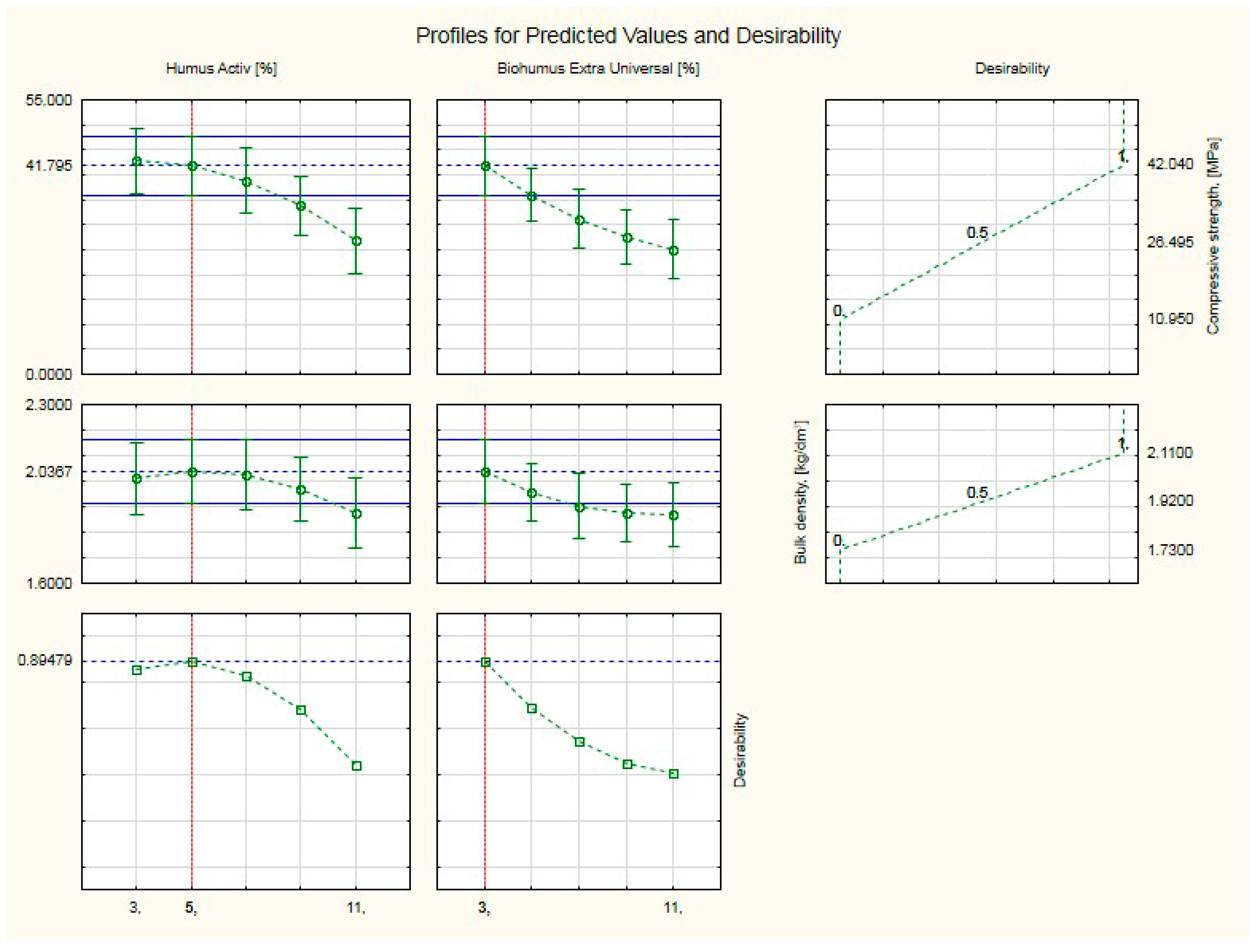
| Type of Modifier (Cases) | Criteria (Features) Variables | ||||
|---|---|---|---|---|---|
| Microsilica Content (MC) [kg/dm3] | Cost (C) [euro/L] | Content NPKCaO (NPK) [mg/L] | Ecological (ES) Sustainability | Aesthetics (AE) | |
| Humus Activ (prod. EKODARPOL) | Yes | 3.3 | 800, 300, 300, 300 | sustainable development | dark gray |
| Biohumus Extra Universal (prod. EKODARPOL) | No/Yes | 2.0 | 700, 300, 300, 1100 | environmentally friendly | dark gray to black |
| Biohumus Forte (prod. AGRECOL) | No | 2.9 | 800, 500, 1200 | environmentally friendly | dark gray to black |
| Biohumus (prod. FERTY-GREEN) | No | 2.4 | 700, 300, 300 | environmentally friendly | dark gray to black |
| Criteria (Features) Variables | |||||
|---|---|---|---|---|---|
| Type of Modifier (Cases) | Micro-Silica Content [kg/dm3] | Costs [euro/L] | NPK Participation | Sustainable Ecology | Aesthetics |
| Humus Activ (HA) (prod. EKODARPOL) | 5 | 1 | 4 | 5 | 2 |
| Biohumus Extra Univ (BEU) (prod. EKODARPOL) | 2 | 5 | 3 | 4 | 1 |
| Biohumus Forte (BF) (prod. AGRECOL) | 2 | 3 | 5 | 4 | 1 |
| Biohumus (B) (prod. FERTY-GREEN) | 2 | 2 | 3 | 4 | 1 |
| № | Independent Factors | |||
|---|---|---|---|---|
| On a Contractual Scale | On a Natural Scale | |||
| X1 | X2 | X1 (HA) (Humus Activ) [%] | X2 (BEU) (Biohumus Extra Universal) [%] | |
| 1 | −1 | −1 | 3 | 3 |
| 2 | 0 | −1 | 7 | 3 |
| 3 | 1 | −1 | 11 | 3 |
| 4 | −1 | 0 | 3 | 7 |
| 5 | 0 | 0 | 7 | 7 |
| 6 | 1 | 0 | 11 | 7 |
| 7 | −1 | 1 | 3 | 11 |
| 8 | 0 | 1 | 7 | 11 |
| 9 | 1 | 1 | 11 | 11 |
| № | Independent Factors | Output Variables | |||
|---|---|---|---|---|---|
| X1 (HA) (Humus Activ) [%] | X2 (BEU) (Biohumus Extra Universal) [%] | Compressive Strength, [Mpa] | Bulk Density [kg/dm3] | Water Absorption [%] | |
| 1 | 3 | 3 | 39.26 | 1.95 | For samples, 9%—the modifier is in a liquid form, so the level of water absorption was reduced to 9% as a result of the modification. 16 |
| 2 | 7 | 3 | 42.04 | 2.11 | |
| 3 | 11 | 3 | 27.17 | 1.85 | |
| 4 | 3 | 7 | 33.54 | 1.91 | |
| 5 | 7 | 7 | 27.95 | 1.85 | |
| 6 | 11 | 7 | 15.17 | 1.75 | |
| 7 | 3 | 11 | 28.22 | 1.87 | |
| 8 | 7 | 11 | 19.12 | 1.81 | |
| 9 | 11 | 11 | 10.95 | 1.73 | |
| 10 | - | - | 20.51 | 1.73 | |
| Variable (Criterion) | Optimal Point Coordinates | The Value of the Objective Function, [MPa] | |
|---|---|---|---|
| Humus Activ, [%] | Biohumus Extra Universal, [%] | ||
| Compressive strength [σ] | 3.01 | 14.47 | 24.37 |
| Variable (Criterion) | Optimal Point Coordinates | The Value of the Objective Function, [MPa] | |
|---|---|---|---|
| Humus Activ, [%] | Biohumus Extra Universal, [%] | ||
| Bulk density [ρ] | 5.33 | 10.33 | 1.87 |
| Criterion | Range of Satisfying Values | ||
|---|---|---|---|
| Low U = 0.00 | Medium U = 0.5 | High U = 1.0 | |
| Compressive strength [MPa] | 20 | 30 | 40 |
| Criterion | Range of Satisfying Values | ||
|---|---|---|---|
| Low U = 0.00 | Medium U = 0.5 | High U = 1.0 | |
| Bulk density [kg/dm3] | 1.73 | 1.92 | 2.11 |
Disclaimer/Publisher’s Note: The statements, opinions and data contained in all publications are solely those of the individual author(s) and contributor(s) and not of MDPI and/or the editor(s). MDPI and/or the editor(s) disclaim responsibility for any injury to people or property resulting from any ideas, methods, instructions or products referred to in the content. |
© 2023 by the authors. Licensee MDPI, Basel, Switzerland. This article is an open access article distributed under the terms and conditions of the Creative Commons Attribution (CC BY) license (https://creativecommons.org/licenses/by/4.0/).
Share and Cite
Dachowski, R.; Stepien, A. Effect of Organic Compounds on the Special Properties and the Microstructure of Autoclaved Brick. Int. J. Environ. Res. Public Health 2023, 20, 3490. https://doi.org/10.3390/ijerph20043490
Dachowski R, Stepien A. Effect of Organic Compounds on the Special Properties and the Microstructure of Autoclaved Brick. International Journal of Environmental Research and Public Health. 2023; 20(4):3490. https://doi.org/10.3390/ijerph20043490
Chicago/Turabian StyleDachowski, Ryszard, and Anna Stepien. 2023. "Effect of Organic Compounds on the Special Properties and the Microstructure of Autoclaved Brick" International Journal of Environmental Research and Public Health 20, no. 4: 3490. https://doi.org/10.3390/ijerph20043490
APA StyleDachowski, R., & Stepien, A. (2023). Effect of Organic Compounds on the Special Properties and the Microstructure of Autoclaved Brick. International Journal of Environmental Research and Public Health, 20(4), 3490. https://doi.org/10.3390/ijerph20043490







